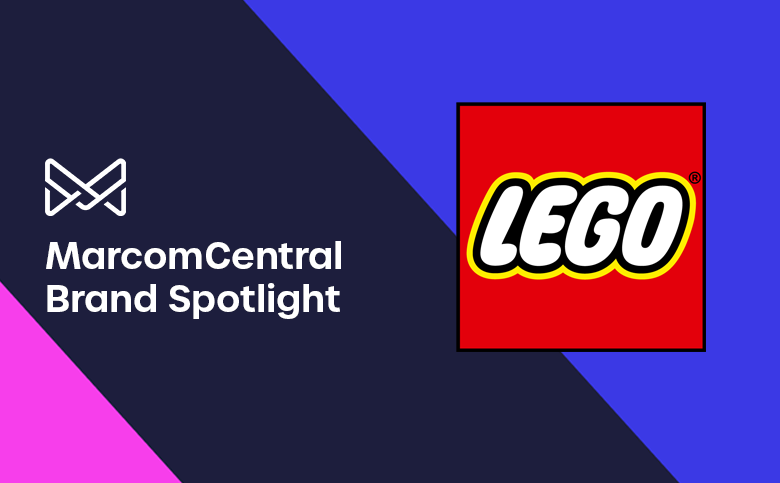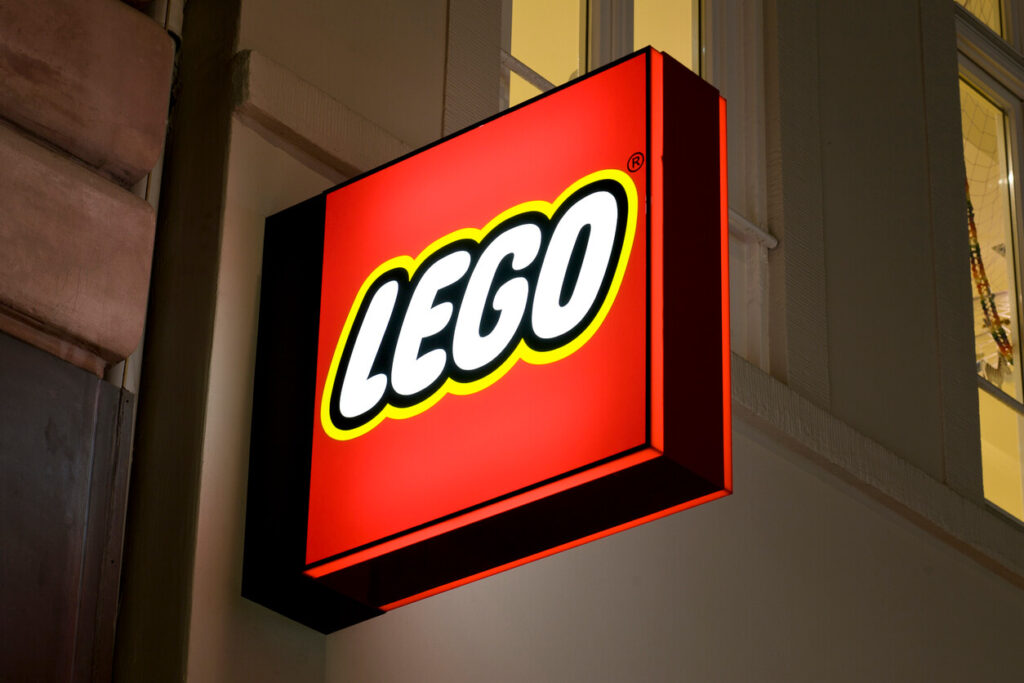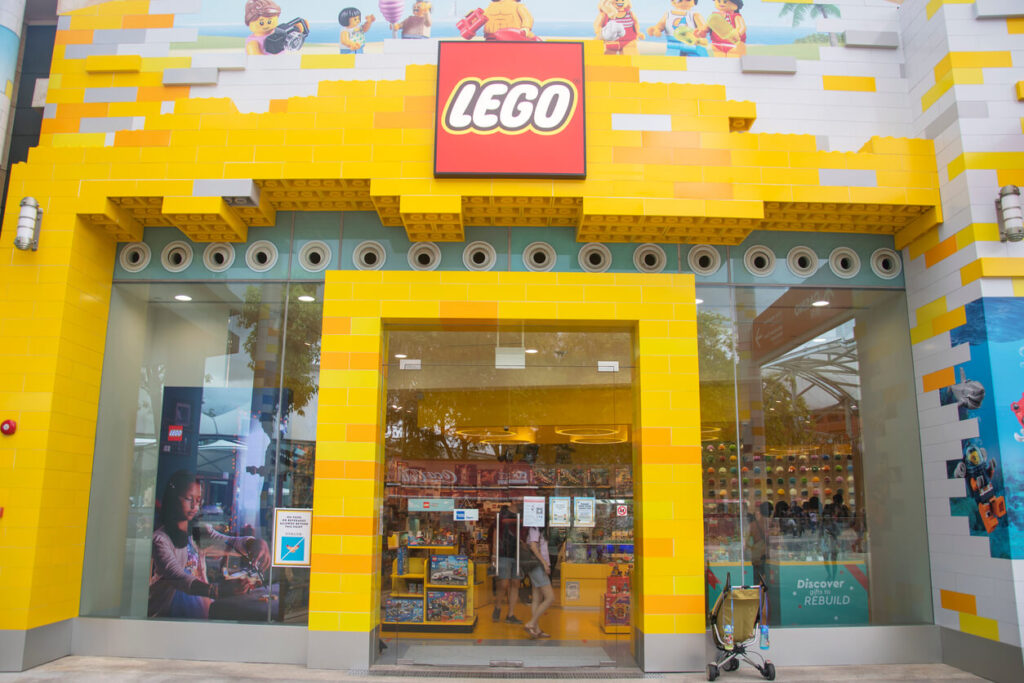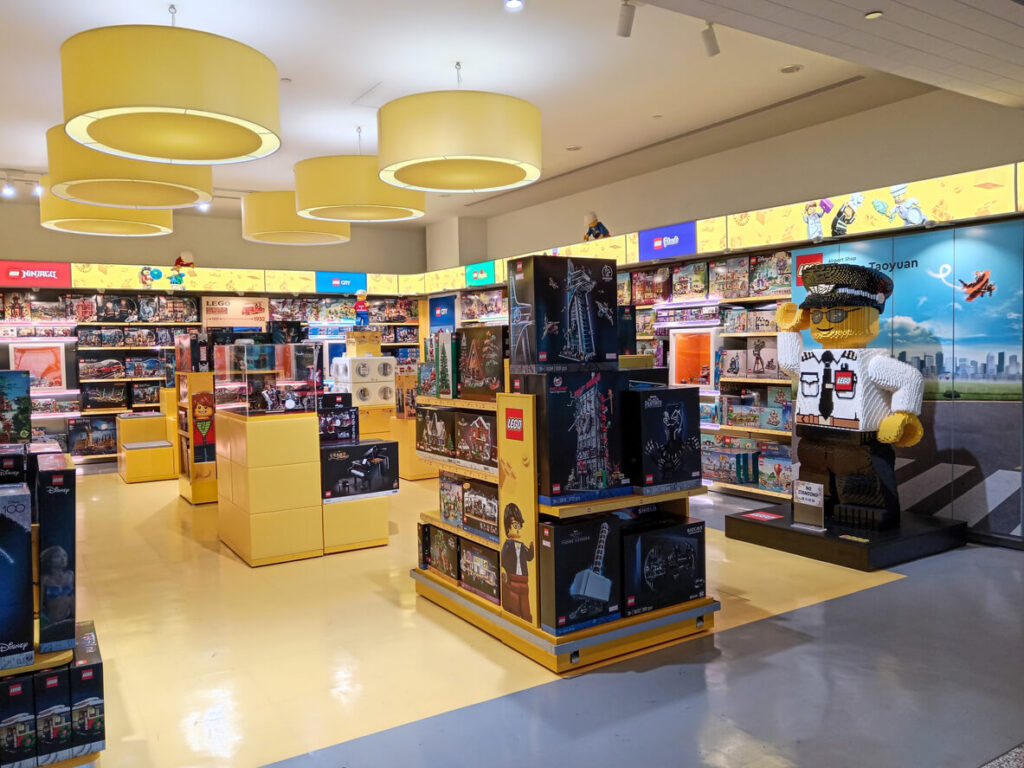- The LEGO Brand Story
- Core Values and Principles
- How LEGO Changed the Toy Industry
- Lego’s Target Market and Demographics
- Previous Lego Marketing Strategies
- Strategic Partnerships
- The Role of LEGO Stores in Brand Strategy
- Results and Impact on LEGO’s Market Position
- Conclusion
Get news, updates, and insights delivered straight to your inbox.
LEGO Marketing Strategy Case Study

When you think of classic children’s toys, you probably think of a few staple items. Alongside dolls and racecars are LEGO building blocks, one of the most popular toys in the world. These plastic building blocks are a favorite among children and adults alike and have remained at the forefront of the toy industry for several decades.
Part of the reason for the success of LEGO is the brand’s ability to adapt to challenges and continue evolving. Another part is their effective marketing strategy, which combines nostalgia-driven and community-focused campaigns with partnerships and collaborations. At MarcomCentral, we help businesses create consistent marketing and branding strategies to help them thrive. Here, we discuss the LEGO marketing strategy in this case study and how it has evolved over time while remaining successful.
The LEGO Brand Story
The LEGO brand was first established in 1932 in Billund, Denmark. It was founded by Ole Kirk Kristiansen, a master carpenter who made wooden toys like cars, airplanes, and yoyos. In 1935, Ole Kirk Kristiansen focused more on his toy production business and aimed to find a new name for it. He came up with the name LEGO by combining two Danish words LEG GODT, which means play well. The new name signifies the brand’s commitment to quality products and encouraging enjoyable play. Since its founding, LEGO has been passed down through generations and is still owned by the Kirk Kristiansen family today.
Although LEGO started with wooden toys made of beechwood, the company started moving beyond wood in 1949. Automatic Binding Bricks made of plastic were launched as the forerunner to the traditional LEGO plastic bricks. The traditional bricks were introduced in 1958, featuring an interlocking design with tubes to offer vast building opportunities. The LEGO products and materials have evolved over the years, but the foundation of the LEGO brick remains largely unchanged. The quality also remains high, evident by LEGO being named “Toy of the Century” twice and becoming one of the world’s largest manufacturers of toys.
Core Values and Principles
LEGO has maintained its core values and principles since its founding. Ole Kirk Kristiansen was dedicated to making high-quality, creative toys that encouraged children’s play from the company’s establishment. In 1957, his son, Godtfred Kirk Christiansen, took over management of the LEGO Group and continued in the quest to provide high-quality toys that help children learn and develop.
Even as the LEGO brand faced challenges, like when the wooden toy warehouse burned down in 1960, it adapted and evolved through innovation. LEGO discontinued their wooden toys and instead focused on additions to their plastic LEGO systems. Every product addition after this follows a set of guidelines that Godtfred Kirk Christiansen established in 1963. The 10 LEGO characteristics help ensure consistent communication for customers and systematic product development for manufacturers. They include:
- Unlimited play possibilities
- For girls, for boys
- Enthusiasm to all ages
- Play all year round
- Stimulating and harmonious play
- Endless hours of play
- Imagination, creativity, development
- More LEGO, multiplied play value
- Always topical
- Safety and quality
These characteristics demonstrate many of LEGO’s core values and principles, including the importance of quality and safety in product development. As time went on, LEGO also developed a commitment to sustainability and environmental responsibility. The aim of this commitment is to help children inherit a healthy planet. The brand has sustainability goals like making products from more sustainable materials by 2032, switching to recyclable packaging, and reducing greenhouse gas emissions to net zero by 2050.
How LEGO Changed the Toy Industry
LEGO is an iconic name in the toy industry, and for good reason. Besides its longstanding popularity, LEGO has changed the toy industry in a multitude of ways. The first way was through the introduction of the interlocking brick system used on LEGO bricks. Although it was not the first ever interlocking brick, the LEGO bricks expanded the design with studs on top and tubes on the bottom. The design was simple, modular, easy for children to use, and also fun for older kids and even adults.
Another way that LEGO has changed the industry is through its expansion into digital experiences like video games and augmented reality. Many other popular toys are tangible for kids to play with but haven’t expanded into the digital realm. LEGO, on the other hand, has created video games for PC and consoles, along with augmented reality apps that can be used to make racetracks appear before the user’s eyes. They also have online games available through LEGO.com that are based on popular movie franchises and themes. This helps kids stay interested in LEGO, even as they may move away from building blocks and get more interested in digital elements.
LEGO also creates themed sets to influence storytelling and appeal to audiences of both genders and different ages. An internal survey in 1965 revealed that LEGO consumers were more likely to be younger children and boys. To remedy this, Godtfred Kirk Christiansen decided to put “more emphasis on play combined with the creative and constructive.” Some of the products that launched with this in mind include:
- Town, Space, and Castle-themed products
- The LEGOLAND line
- The LEGO Minifigures
These products aim to enhance play with roleplaying and encourage kids to build their own worlds and creations. This is just another way that LEGO has changed the toy industry.
LEGO has also developed a focus on community engagement, which helps other LEGO lovers connect and get inspiration. LEGO Ideas was launched in 2014 as a way for fans to submit their own designs, which can potentially be turned into real LEGO sets. Fans are also encouraged to share their unique creations on social media. LEGO frequently features fan-made content on its official channels. This concept has also changed the industry by boosting the community in creativity.
Lego’s Target Market and Demographics
As LEGO originated as a children’s toy company, it makes sense that their primary target audience started as young children. The company aimed to make toys that both boys and girls would want to play with. With LEGOLAND parks, mini figures, and themed sets, LEGO continues to be a favorite toy among younger kids.
As LEGO expanded, they continued adapting their core products to appeal to older children and teenagers, including offering LEGO Technic and more complex sets. Niche markets were also introduced, including sets with education, robotics, and STEM themes. Instead of just building towns and castles, young adults can make programmable robotics, scientific sets, educational tools, and more.
Although LEGO is a favorite toy among kids and teens, the company is also successful with adult collectors. The adult fan base, known as adult fans of LEGO (AFOLs), is targeted through a variety of means, including the nostalgia of playing with LEGOs as children and collaborating with adult favorites. Themed sets, including Star Wars, Harry Potter, and Marvel, are based on popular franchises and encourage adults to buy. Architecture and botanical sets can even be displayed around the house or in offices once they’re built, adding to the appeal.
Previous Lego Marketing Strategies
LEGO has utilized a variety of marketing strategies and techniques to remain relevant and cement the company as a staple in the toy industry and beyond. They include:
Nostalgia-Driven Campaigns
One of LEGO’s main marketing strategies is to utilize nostalgia-driven marketing campaigns. Nostalgia is a powerful emotion that can take us back to times past. LEGO taps into this emotion by using campaigns that evoke memories of childhood and adolescence. They help remind customers of the creativity and joy associated with using LEGO in their childhoods. This helps create an emotional connection that makes customers want to continue to use and buy LEGO, even when they’re grown. LEGO has also relaunched classic sets to appeal to older generations who may have played with the original sets.
Themed Sets and Franchise Collaborations
Another marketing strategy of LEGO is to collaborate with franchises that both children and adult fans love. The company has had successful partnerships with franchises like:
- Star Wars
- Super Mario
- Marvel
- Harry Potter
- Lord of the Rings
- Indiana Jones
- Disney
- Wicked
They release sets with themes based on these favorites, which are often very popular sellers. Even if adults aren’t already LEGO fans, they may be tempted to buy a themed set to tap into their inner child or display something from their favorite movie. Children often want as many items as possible of their favorite characters, so LEGO has also released themed sets with characters from Peppa Pig and Fortnite. These make children want LEGO sets and can pique their interest in the toy, even if they weren’t already interested.
Digital and Interactive Play
Embracing digital and interactive play is another LEGO marketing tactic. This has helped them expand into areas besides toys, like video games and mobile app integration. Even if kids or adults aren’t likely to play with the bricks themselves, these digital experiences may appeal to them. LEGO has also explored augmented reality through a digital app, where you can scan your racetrack creations and see them as racetracks which you can play games on. This marketing strategy also extends to LEGO stores and LEGOLAND theme parks, where guests can enjoy interactive experiences. This helps bridge the gap between tangible toy products and real-life experiences, which can boost interest in LEGO.
Community-Driven Marketing
The community component of LEGO’s marketing strategy is also a major part of its success. LEGO Ideas lets fans create unique creations and post them on their site, with the opportunity for them to become real products. This is something that isn’t offered by many companies and helps fans feel valued. LEGO also utilizes user-generated content from the LEGO community, sharing them on their social media sites. By showcasing fan creations in social media campaigns, LEGO emphasizes the importance of creativity and the value of their customers. This helps reinforce their brand values and provide a competitive advantage over other toy companies.
Strategic Partnerships
LEGO sets were popular when they only involved bricks, cars, and mini figures. However, by making strategic partnerships with entertainment companies and franchises, they have reached even bigger heights. These collaborations help LEGO target new audiences, including people who haven’t played with them as kids. Themed sets with companies like Disney, Warner Bros., Minecraft, and PlayStation feature figurines of favorite characters, allowing the company to tap into their fanbases. These partnerships have helped LEGO reach record profits.
LEGO has also played a role in education and STEM programs by making hands-on STEAM solutions for kids of all age groups. These learning tools are created to empower students to become engaged and interested in learning. The sets even come with lesson plans for teachers, encouraging use in the classroom and school districts. These STEAM collaborations also help LEGO reach new audiences in educators and parents who want an educational toy for their kids to play with.
The Role of LEGO Stores in Brand Strategy
If you’ve ever been walking through the mall or busy city street and see a line of kids waiting outside a store, chances are it’s a LEGO store. These destinations play a big part in the brand’s strategy, helping to continue and convey their message of creativity, play, and community.
Enhancing the Brand Experience
The LEGO stores offer children (and adults) an interactive shopping experience where there are free play areas, life-size models, special events, exclusive product launches, and more. The Pick a Brick walls are found in every store that allow for the purchase of individual bricks. Some stores also have Minifigure Factories, where customers can design a customized LEGO Minifigure. These features help LEGO create a consistent brand identity and enhance the brand experience. This also increases customer satisfaction and boosts sales.
Expanding Brand Reach
LEGO stores have also helped the company expand their brand reach. By strategically placing stores in high-traffic areas, such as in New York’s Fifth Avenue, London’s Leicester Square, and California’s Downtown Disney District, LEGO can attract tourists and consumers that aren’t part of their typical audience. These locations also help LEGO break into new markets.
LEGO stores help to strengthen the brand’s physical presence by advertising in many different popular areas. The immersive customer experience offered within the stores also helps to enhance brand loyalty, as they offer unique benefits that can’t be accessed at other stores.
Driving Community Engagement
LEGO stores also aid in driving community engagement within the physical locations. Many stores host events, workshops, and meetups where LEGO fans can come together and foster community connections. Customers who visit the stores are also encouraged to participate in in-store competitions and showcases, which makes them feel valued and a part of the LEGO community. Along with building community in the stores, the LEGO digital presence also supports community connections and interaction through hashtags, sharing fan creations on social channels, and more.
Results and Impact on LEGO’s Market Position
The different aspects of LEGO’s marketing strategy, including nostalgia-driven campaigns, community interaction, and calculated partnerships, have all had a favorable impact on the brand’s market position. The results include:
Financial Growth
LEGO has been the toy industry’s leading company for many years, with a strong brand value that staggers over its competitors. In 2024, LEGO was the most valuable toy brand in the world with a brand value of nearly eight billion U.S. dollars. Among all the major toy industry brands, LEGO accounted for the highest annual revenue.
Both LEGO’s market share and revenue increased in the first half of 2024, significantly outperforming the wider toy industry. Part of this growth was attributed to LEGO’s partnership with Epic Games and its space product line. The use of effective marketing techniques also helps improve brand perception, which make them valued as more than just a toy company, but also as an encourager of creativity, play, and growth. This is another example of how LEGO’s strategic partnerships and marketing tactics benefit the brand.
Sustainability and Long-Term Success
In 2018, the first LEGO elements made from sustainable elements were added to the product lineup. Since then, LEGO has continued a commitment to eco-friendly practices, including:
- Using more sustainable materials in LEGO bricks and packaging
- Reducing the environmental impact of operations by reducing greenhouse gas emissions
- Improving energy efficiency by using renewable energy sources for factories, offices, and stores
- Partnering with World Wildlife Fund (WWF) to promote global action on climate change
LEGO has also said that the company’s increased profits will help fund its use of renewable and recycled material. This commitment to sustainability is one way that LEGO stays relevant, along with social responsibility initiatives and collaborations with pop culture phenomena like Wicked and Wednesday Addams.
Conclusion
With LEGO becoming the most popular toy company in the world and continuing to raise its profits, it’s evident that its marketing strategies and business model have been effective. By focusing on a consistent brand message and quality customer experience, LEGO has enjoyed longstanding success. If your company is looking to revive your brand, having a consistent brand message and values is of utmost importance. MarcomCentral can help create a reliable brand message to help your company thrive. Discover how MarcomCentral can elevate your brand’s marketing strategy. Request a Demo today.
You might also like





